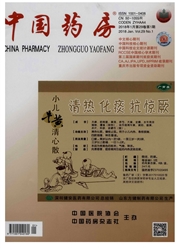

 中文摘要:
中文摘要:
目的:优化建泽泻盐炙工艺并建立其高效液相色谱(HPLC)指纹图谱。方法:以23-乙酰泽泻醇B、总三萜含量和外观性状综合评分为指标,采用单因素试验和正交试验,优化建泽泻盐炙工艺中用盐量、炒制温度和炒制时间3个因素的水平。采用HPLC法分别在208、245 nm波长下建立10批建泽泻盐炙品的指纹图谱,经软件比较其与对照图谱的相似度。结果:最优工艺为每100 kg泽泻加10 kg水溶解的2 kg盐,闷润1 h,在100℃下炒制8 min。验证试验中,3批盐炙品外观性状均符合要求,综合评分平均值为93.94(RSD=6.63%,n=3);23-乙酰泽泻醇B和总三萜含量稳定,RSD分别为7.41%、7.39%(n=3)。在208、245 nm波长下分别标定了建泽泻盐炙品的17、10个共有峰;10批样品指纹图谱相似度均大于0.9。结论:优化的建泽泻盐炙工艺合理可行、重现性好;建立的指纹图谱共有峰稳定,可用于建泽泻盐炙品的质量评价。
 英文摘要:
英文摘要:
OBJECTIVE: To optimize the stir-bake with saltwater processing technology for Fujian Alismatis rhizoma, and es- tablish its HPLC fingerprint. METHODS: Using 23-acetyl alisol B, total triterpenoids contents and appearance as comprehensive in- dexes, single factor experiment and orthogonal test were employed, 3 factors' levels including the quantity of salt, processing tem- perature and time were optimized. HPLC was used to develop fingerprints of 10 batches of Fujian Alismatis rhizoma at wavelength of 208, 245 nm; the similarity between fingerprints and control profile was compared by using software. RESULTS: The optimal technology was as follow as 2 kg salt dissolved with 10 kg water for each 100 kg Fujian Alismatis rhizoma, moistening for 1 h, stir-frying for 8 minutes under 100 ℃. In verification test, the appearance of 3 batches of processed products were all in line with requirements, average comprehensive score was 93.94 (RSD=6.63%, n=3); 23-acetyl alisol B and total triterpenoids contents were stable (RSD=7.41%, 7.39%, n=3), respectively. Totally 17 and 10 common peaks were marked in 208 nm and 245 nm re- spectively; similarities of 10 batches of samples' fingerprints were higher than 0,9. CONCLUSIONS: Optimized stir-bake with salt- water technology is reasonable, feasible, and reproducible; the stability of common peaks of established fingerprints can conduct ef- fective quality evaluation for Fujian Alismatis rhizoma processed by saltwater.
 同期刊论文项目
同期刊论文项目
 同项目期刊论文
同项目期刊论文
 期刊信息
期刊信息
